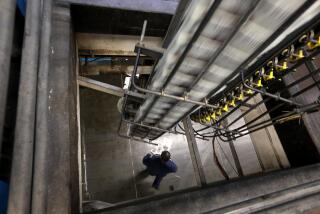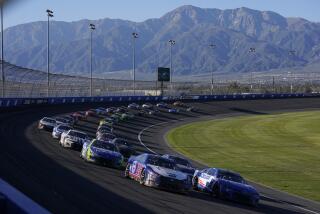How the Former Kaiser Companies Have Fared : Steel: Fontana Mill Is Still Operating--but It’s Only a Shell of Its Former Self
The cavernous plant at Fontana is noisy again; steel is being rolled or pulled into usable shapes throughout a 400-acre section.
But the droning of machines and the staccato of workers’ shouts are mere echoes. More than 10,000 steelworkers used to draw Kaiser Steel paychecks; now, fewer than 700 employees of a new company called California Steel Industries work at the mill.
In the rest of the 1,800-acre facility, workers are ripping out the old steelmaking equipment, demolishing the ovens, furnaces and ladles that had been used since Henry J. Kaiser built the plant to meet the demand for steel on the West Coast during World War II.
The old equipment will be sold as scrap. The emptied part of the plant may be turned into an industrial park, where other companies would make products more suited to today’s Western economy. And Kaiser Steel, a company in metamorphosis, will have finished shedding yet another unneeded layer.
Part of a Chain
The Fontana Works, built in 1942 and expanded several times since then, was part of a finely crocheted chain of Kaiser Steel holdings: land that provided the raw minerals and water power, plants and equipment that made steel plates, sheets and bars, other companies that turned the steel into pipes, girders, oil drilling platforms, bridges and buildings, and a subsidiary that shipped coal and iron ore.
But from the beginning, Kaiser Steel’s big plant seemed to be struggling constantly to overcome hardships. The first two were built in: its location (55 miles inland, a wartime concession to fears of coastal attacks) and size (restricted to wartime needs by the lending governmental agency). The Fontana Works underwent several expansions and modernizations in coming years--some to keep up with rapidly evolving technology, others to meet standards of air pollution control. But it always seemed to be a case of too little, too late.
Additionally, through the years imported steel took an increasingly larger share of the West Coast market, and a cost-savings sharings plan for its workers became a cost burden itself.
As its problems grew, Kaiser Steel made attempts to get out of basic steel manufacturing. The first was reversed in 1975, when the company decided instead to begin a $250-million modernization program. But the move out of basic steelmaking was revived in 1980, by new Chairman Edgar F. Kaiser Jr., Henry J.’s grandson. Under Kaiser, the steel company began to sell off assets and study the shutdown of its steelmaking operations. Kaiser, one of several short-term chief executives, left after 16 months. In November, 1981, the company accepted a plan to phase out steelmaking.
Works Was Closed
That same year, the Kaiser Family Foundation began looking for a buyer for its 18% stake in Kaiser Steel. Although there were several bidders, no deals were struck. In December, 1983, the Fontana Works was closed.
Early the next year, two investor groups bought Kaiser Steel for $374.4 million. Later, the investors sold the most modern section of the plant for more than $110 million to California Steel Industries, a partnership of local, Brazilian and Japanese interests.
And this year, Monty Rial, principal in Denver-based Perma Resources Group, bought out his partners in Kaiser Steel, an investor group headed by Tulsa financier J. A. Frates. Rial now operates Kaiser Steel as a closely held company, primarily engaged in coal mining. Earlier this week, Rial cut the corporate staff by one third.
At Fontana, California Steel is rolling imported steel slabs for use in construction, shipbuilding, transmission pipes and dozens of other products. It is operating the finishing facilities at an annual rate of 1 million short tons of steel, about 40% of the plant’s capacity.
And the company is considering firing up the modernized steel-manufacturing shop and making its own steel slabs. It would take about two years and considerable financing, but “it is something we want to do,” said Howard Wilkinson, spokesman for California Steel.
KAISER STEEL AT A GLANCE
Year ended Dec. 31 (in millions): 1984 1983 1982 Revenue $151.2 $226.9 $734.9 Net income (loss) 47.7 (422.8) 2.6
More to Read
Inside the business of entertainment
The Wide Shot brings you news, analysis and insights on everything from streaming wars to production — and what it all means for the future.
You may occasionally receive promotional content from the Los Angeles Times.








